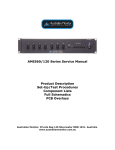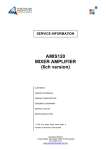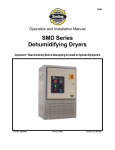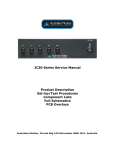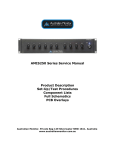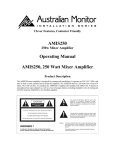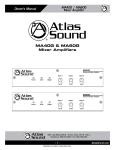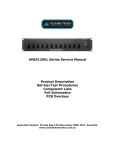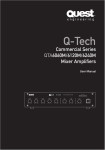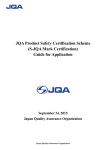Download the Australian Monitor AMIS60 Operating Manual
Transcript
Clever Features, Contactor Friendly Operating Manual AMIS60, 60w Mixer Amplifier & AMIS120, 120w Mixer Amplifier Product Description The AMIS60 and AMIS120 mixer amplifiers are designed for commercial installations. Both models operate on 230 VAC, 50Hz or 24 VDC, and may be desk or rack mounted (rack mount kit supplied fitted). Both amplifiers incorporate a 6 zone 100 volt line speaker zone selector with “All Call”. The AMIS60 will deliver 60 watts into a load of 8 ohms, 70 volt or 100 volt line. The AMIS120 will deliver 120 watts into a load of 4 or 8 ohms, 70 volt or 100 volt line. Both Models feature 4 universal mic/line inputs, and an insert point for additional EQ or feedback exterminator if required. The AMIS60/120 also feature a dual RCA tape output while a balanced, 700mV XLR output is also provided to feed up to six power amplifiers. Other standard features include on-board Bell, Pre Announce, Alert & Evac tones, Remote Master VCA Control & dual stage priority muting. As standard, both models are self standing and come with rubber feet. They may be stacked to a maximum of four units high. Thank You For Your Business, We Appreciate Your Support Front Panel Features (AMIS60 shown. The AMIS120 has identical front panel features) Microphone/Line Level Controls The AMIS60/120 features 4 universal mic/line input controls labeled Ch 1 through to Ch 4 and should be adjusted to provide the required level mix for each individual channel. Start with the controls set to level ‘0’ and turn the controls clockwise until the desired mix level for each channel is reached. Bass Control Setting this control in the centre position will give an overall flat bass response. Adjusting the bass control in a clockwise direction will provide up to 12 dB of bass boost @ 100 Hz. Adjusting the bass control in a counter-clockwise direction will provide up to -12 dB of bass cut @ 100 Hz. It is recommended to start with the bass control at the centre ‘0’ position and adjust if necessary. Treble Control Setting this control in the centre position will give an overall flat treble response. Adjusting the treble control in a clockwise direction will provide up to 9 dB of treble boost @ 10kHz. Adjusting the treble control in a counter-clockwise direction will provide up to -9 dB of treble cut @ 10 kHz. It is recommended to start with the treble control at the centre ‘0’ position and adjust if necessary. Master Output Control The master level pot controls the overall output level of the amplifier depending on the levels set for the individual input channels as detailed above. Start with the control set to level ‘0’ and turn clockwise until the desired output level of the amplifier is reached. The Master Output Control can also be operated via remote VCA (see rear panel description) Page Chime Enable Button This allows the user to disable or enable the Pre-Announce Chime. This switch does not activate the chime. Activation is accomplished via the rear panel barrier strip (normally wired to a paging microphone). If the pre-announce chime is connected to a paging microphone (meaning that it would be activated by the switch on the microphone), the Page Chime Enable switch on the front panel of the amplifier allows the user to disable the chime function on those occasions when it is not require All Call Button When pressed, the All Call button will connect the 100 volt output of the amplifier to all 6 of the switched outputs (if connected). Depressing this button again will disconnect the switched outputs. This switch is “push on-push off” and is non-interlocking. Speaker (Zone) Selector Switches These 6 black buttons are for switching the 100 volt output of the amplifier to any combination of the 6 available speaker zones. The switches are “push on-push off” and are non-interlocking (both with each other and with the all-call button). The maximum capacity of each speaker zone is 60 watts so care should be taken to ensure that no individual zone is loaded down with any more than 60 watts, always remembering that the total load for the AMIS60 is 60 watts and for the AMIS120, 120 watts in total. Eg; it is possible on the AMIS120 to safely have one zone loaded with 60 watts and the remaining five loaded with 12 watts each. Power Switch This switch controls the switching of AC power to the amplifier. Rocking this switch upwards turns ‘on’ AC power to the amplifier while rocking the switch downwards turns power ‘off’ to the amplifier. A blue LED above the switch will indicate whether the amplifier is switched ‘on’ or ‘off’. This will not switch DC power ‘on’ or ‘off’ in DC operation. In DC operation mode, the amplifier is always ‘on’. Rear Panel Features (AMIS60 shown. The AMIS120 has identical rear panel features) 230V/240V Slide Switch The operating voltage of the amplifier is user selectable between 230V and 240V via a slide switch located on the top left side of the rear panel. This switch should be set to match the AC voltage of your country. AC Power Inlet The 3 pin IEC power inlet is located on the bottom left of the rear panel and accepts a standard mains power lead fitted with an IEC connector. Before plugging in a power lead, please check the rear panel of the amplifier to ensure that the voltage switch is set correctly for your part of the world. The operating voltage is 230/240 VAC @ 50 Hz. The inlet is equipped with an inbuilt AC fuse holder fitted with a 4 amp fuse (ACM120) or a 2 amp fuse (ACM60) plus a spare within the holder. Power consumption is 125 VA for the AMIS60 and 250 VA the AMIS120. ---- Please ensure that the mains power cord is disconnected before attempting to check or replace this fuse---- 24 Volt DC Power Inlet The AMIS60 & AMIS120 feature optional 24VDC power to run off a battery supply if required. This is connected via the rear terminal strip. The front panel Power Switch will not switch DC power ‘on’ or ‘off’ in DC operation. In this mode the amplifier is always ‘on’. Speaker Output Terminal Strip The screw terminals on the left hand side of the strip allow access to the direct speaker outputs of the amplifier. The screw terminals on the right hand side are for activation of the in-built 4 tone generator. Reading from left to right the terminals are: COM 4 8 Common or “-” for low impedance speaker loads (4 or 8 ohms). Positive “+” for 4 ohm speaker loads (use with common) (AMIS120 only) Positive “+” for 8 ohm speaker loads (use with common) COM Common or “-” for 70v or100v speaker loads (maximum load of 80 ohms at 100v AMIS120 & 160 Ohms at 100v AMIS60) Positive “+” for 70v line speaker loads (use with common) Positive “+” for 100v line speaker loads (use with common) 70 100 Please ensure that the correct “Common” is used. Low impedance and 70/100v loads can be used simultaneously but please pay careful attention to the overall speaker load. When used individually, the low impedance load should be 4 ohms or higher while the 100v line load should not fall below 80 ohms. When both outputs are used simultaneously, ensure that neither output is loaded to maximum. Spare Tone Generator Common (use with one of the 4 tones listed below) Pre-Announce Chime Alert Tone Bell Chime Evacuation Tone 24 volt DC Vox Relay Out VCA Note: The minimum impedance (or maximum load) at 100 volt line should be no less than 80 Ohms for the ACM120 and no less than 160 Ohms for the AMIS60. Speaker (Zone) Output Terminal Strip Reading from left to right, these screw terminal pairs correspond to the switched 100 volt line outputs and are numbered 6 through 1 as indicated on the front panel of the amplifier. For each pair, the left hand terminal is the 100 volt output and the right hand terminal is the common. Phantom Power Button This button enables or disables the 15 volts DC phantom power which is available on all microphone inputs (XLR’s). The “in” position indicates that phantom power is ‘on’ for all mics. The “out” position means that phantom power is switched ‘off’ for all mics. Phantom power is required for electret condenser microphones that require DC power to operate. While some of these microphones can operate from an internal battery, having phantom power available on the amplifier eliminates the need to regularly change batteries in the microphone. While phantom power is not required for the more common Dynamic microphones, it will not damage them providing they are balanced. Do not plug an unbalanced microphone in to any amplifier or mixer when phantom power is switched ‘on’. Line Output The balanced XLR line level output provides a maximum of 700mV to allow for the connection of up to 6 power amplifiers. Simply run a balanced cable from the line out of the AMIS60 or AMIS120 to the line input of the power amplifier. Pin connections are: pin #1-earth; pin #2-signal (high, +); pin #3-signal (low, -). Tape Output Dual RCA output connectors provide a line level output with a maximum of 350mV into 10K Ohms which is ideal for connection to most standard tape recorders. This output is sourced before the master gain control and as such, the tape output level is not influenced by the operation of the master gain control. Microphone Inputs All four inputs are dual mic/line with microphone inputs being via a 3 pin XLR connector per channel. The mic input sensitivity is 1mV @ 200 ohms. Pin connections are: pin #1-earth; pin #2-signal (high, +); pin #3-signal (low, -). Phantom power of +15 volts is available on all microphone inputs. Reading from left to right across the rear panel, the inputs are 4, 3, 2, & 1. Line Inputs All four inputs are dual mic/line with line/auxiliary inputs being via dual RCA connectors per channel. Line inputs 1, 2 & 3 have an input sensitivity of 150mV @ 100K ohms. Input 4 has an input sensitivity of 300mV @ 220K ohms making it suitable for high level inputs such as a CD player. Reading from left to right across the rear panel, the inputs are 4, 3, 2, & 1. Insert Point The AMIS60 & AMIS120 include an Insert Point to allow for connection of signal processors such as equalisers, compressors or Feedback Exterminators. The Insert Point is located (electronically) between the mixer and power amplifier sections of the AMIS60 &AMIS120. It allows for the “mixed” output of the amplifier to be processed externally and then returned to the power amplifier section of the AMIS60 & AMIS120. The Insert Point is a 3 conductor (Tip, Ring, Sleeve) socket which accepts a standard stereo 6.35mm (1/4”) jack. The one jack allows for signals to be “sent” to the processor and then “returned” to the power amplifier. The connections are: Tip Amplifier in. This is the return signal from the processor Ring Mix Output. This is the signal from the mixer stage which is to be sent to the processor Sleeve This is the ground connection When an external processor is used via the insert point, it only affects the power amplifier section of the AMIS60 &AMIS120. The tape output remains unprocessed VOX Relay Output The terminal strip to the immediate right of the AC inlet features a relay output. This relay is activated when signal is present at any of the priority inputs. This would normally be inputs 1 and 2 however, these channels can be removed from the priority bus via internal links (see “Muting” further on in this manual). The unit is shipped from the factory with inputs 1 and 2 having priority so assuming that this has not been changed, signal at any of these inputs will activate the VOX relay circuit. The relay outputs are C (Common), NO (Normally Open) and NC (Normally Closed). The NO or NC selection provides the installer with the option of the relay either opening or closing a contact. This feature is normally used in conjunction with relay override attenuators (volume controls). In this application, the relay output could trigger an accessory power supply which in turn bypasses the remote attenuators. The result is that priority inputs will always be heard irrespective of the attenuator setting. The relay contacts are 3 amps at 125VAC/30VDC. VCA Control An external pot (500K) can be connected to the AMIS60/120 for remote control of the master level. The external pot is governed by the master level of the amplifier allowing the installer to set the volume, then lock the amplifier in a rack, leaving the user with just a master volume control that cannot go beyond the level set on the master (front panel) control. Connection is via a 2 wire terminal strip on the rear panel of the amplifier. Other Features Tone Generators Four separate tones are available from the in-built tone generator board. All four tones can be activated individually via a contact closure connected to the screw terminals on the rear of the amplifier. To activate the bell chime for example, just run a pair of wires from the Tone generator common and the Bell terminal to an external switch. Activating the switch, or closing the pair of wires, will activate the bell. When any tone is activated, all inputs (except for inputs 1 and 2) will automatically mute. To adjust the level of the tone generator, disconnect the power lead, remove the amplifier lid and locate the pot labeled R6. (located behind the Bass adjustment pot). This pot adjusts the level for all 4 tones. Tones available on the AMIS60 and AMIS120 include: - Evacuation Tone - Alert Tone - Bell Tone - Pre-Announce Chime Muting A VOX muting card is installed in the AMIS60 and AMIS120. This feature provides automatic muting of some channels when others are active. It is normally used so that a paging microphone can have priority (by muting) over background music. VOX muting is available from channels 1 and 2, meaning that any signal on channels 1 and 2 (mic or line) will mute channels 3 & 4. The muted channels will automatically ramp back up to normal volume when the signal on channels 1 and/or 2 is no longer active. The amplifier ships with the VOX muting function enabled. To disable the VOX muting, disconnect the mains power lead and remove the lid of the amplifier. Looking down from the front of the amplifier, a three position jumper (labeled JP2) is located just to the left and behind the level pot for channel 1. To disable VOX muting, move the jumper to the middle and left pins. (Factory setting is with VOX enabled with the jumper on the middle and right pins). Fuse Sizes Mains AMIS60, 230 VAC: 2 Amperes Slow Blow Mains AMIS120, 230 VAC: 4 Amperes Slow Blow Notes The DC fuse is located on the circuit board. This is a feature of the AMIS series amplifiers, which are equipped with a current limiting circuit preventing excessive DC currents, thus eliminating the risk of blowing high tension fuses. In the unlikely event that the DC fuse actuates, the output transistors should be checked, as it is probable that the amplifier has been subjected to very extreme conditions. Important Safety Information 1. Save the carton and packing material even if the equipment has arrived in good condition. Should you ever need to ship the unit, use only the original factory packing. 2. Read all documentation before operating your equipment. Retain all documentation for future reference. 3. Follow all instructions printed on unit chassis for proper operation. 4. Do not spill water or other liquids into or on the unit, or operate the unit while standing in liquid. 5. Make sure power outlets conform to the power requirements listed on the back of the unit. 6. Do not use the unit if the electrical power cord is frayed or broken. The power supply cords should be routed so that they are not likely to be walked on or pinched by items placed upon or against them, paying particular attention to cords and plugs, convenience receptacles, and the point where they exit from the appliance. 7. Always operate the unit with the AC ground wire connected to the electrical system ground. Precautions should be taken so that the means of grounding of a piece of equipment is not defeated. 8. Mains voltage must be correct and the same as that printed on the rear of the unit. Damage caused by connection to improper AC voltage is not covered by any warranty. 9. Have gain controls on amplifiers turned down during power-up to prevent speaker damage if there are high signal levels at the inputs. 10. Power down & disconnect units from mains voltage before making connections. 11. Never hold a power switch in the “ON” position if it won’t stay there itself! 12. Do not use the unit near stoves, heat registers, radiators, or other heat producing devices. 13. Do not block fan intake or exhaust ports. Do not operate equipment on a surface or in an environment which may impede the normal flow of air around the unit, such as a bed, rug, weathersheet, carpet, or completely enclosed rack. If the unit is used in an extremely dusty or smoky environment, the unit should be periodically “blown free” of foreign matter. 14. Do not remove the cover. Removing the cover will expose you to potentially dangerous voltages. There are no user serviceable parts inside. 15. Do not drive the inputs with a signal level greater than that required to drive equipment to full output. 16. Do not connect the inputs / outputs of amplifiers or consoles to any other voltage source, such as a battery, mains source, or power supply, regardless of whether the amplifier or console is turned on or off. 17. Do not run the output of any amplifier channel back into another channel’s input. Do not parallel- or series-connect an amplifier output with any other amplifier output. Australian Monitor is not responsible for damage to loudspeakers for any reason. 18. Do not ground any red (“hot”) terminal. Never connect a “hot” (red) output to ground or to another “hot” (red) output! 19. Non-use periods. The power cord of equipment should be unplugged from the outlet when left unused for a long period of time. 20. Service Information Equipment should be serviced by qualified service personnel when: A. The power supply cord or the plug has been damaged. B. Objects have fallen, or liquid has been spilled into the equipment C. The equipment has been exposed to rain D. The equipment does not appear to operate normally, or exhibits a marked change in performance E. The equipment has been dropped, or the enclosure damaged. Engineered in Sydney, Australia www.australianmonitor.com.au International Sales & Corporate Head Office Private Bag 149, Silverwater NSW 1811 149 Beaconsfield Street, Silverwater NSW 2128 Australia Ph: 61-2- 9647 1411 Fax: 61-2-9748 2537 E-mail: [email protected]








